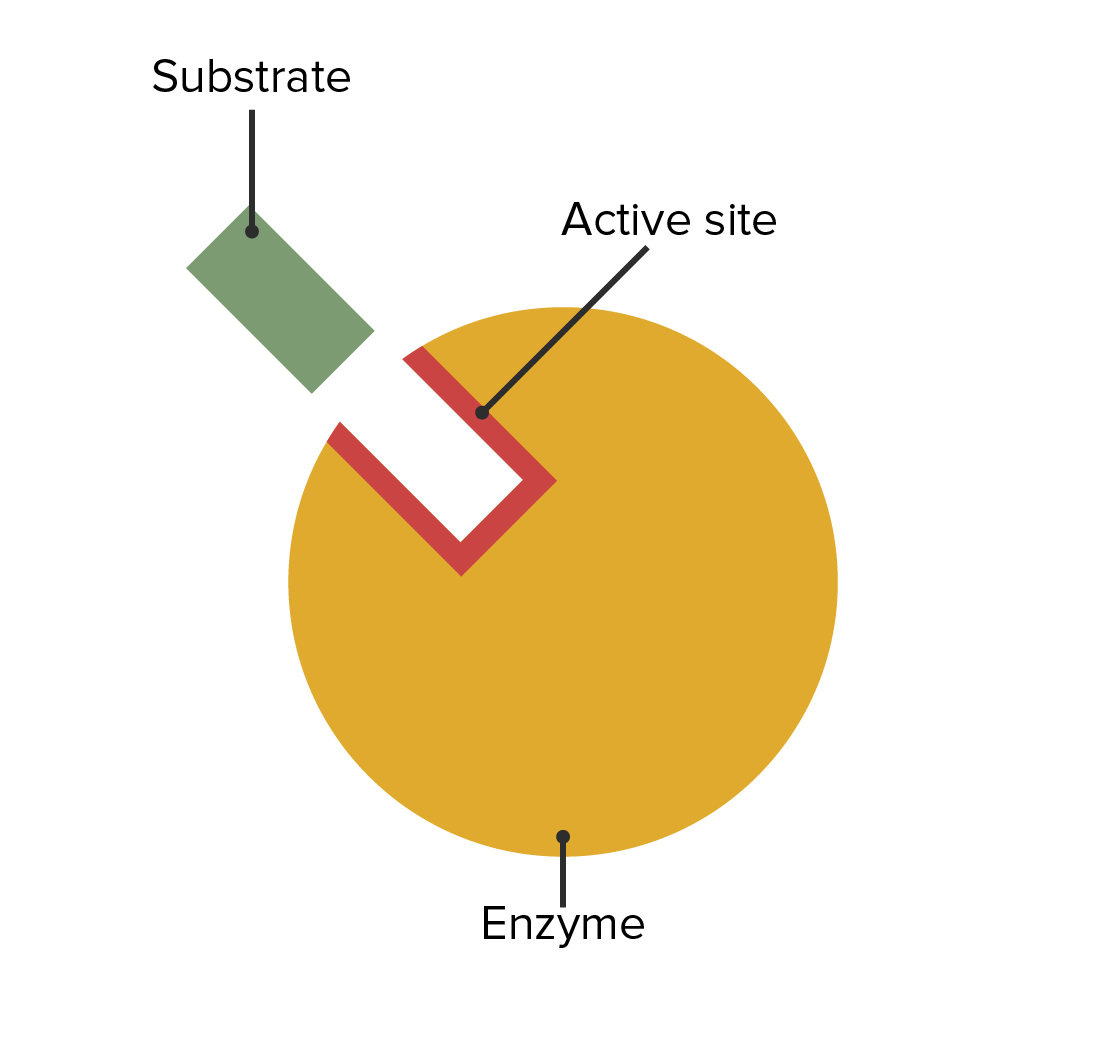Playlist
Show Playlist
Hide Playlist
Enzymes: Introduction
-
Slides 11 Chemistry Advanced Le Gresley.pdf
-
Download Lecture Overview
00:02 Now, we are going to continue our discussion of bio-chemical interactions by discussing enzymes. The aims of this particular lecture are to introduce enzymes and identify why they are important drug targets. 00:16 We will also be considering enzyme inhibitors and show you how to categorise them as reversible/irreversible and either competitive or non-competitive. 00:28 We will also be considering the mode of action in the basic sense of aspirin, a COX-1 inhibitor. 00:36 So, what are enzymes? As you can appreciate, as per in the laboratory, many many reactions occur within the body. They take place in aqueous solution. They... enzymes themselves must work efficiently and in excellent yields and they must be reliable. 00:55 And the role of an enzyme is essentially a catalyst. All be it a biological catalyst that lowers the activation energy of a specific reaction. 01:05 So, how do these factors differ from lab based organic chemistry? In order for biological chemistry to work, these complex catalysts called enzymes control specific reactions. 01:18 And what is the definition of a catalyst? Putting it simply, a catalyst is something which increases the rate of a specific reaction by lowering the activation energy. And in the case of enzymes, all there are is biological equivalence of these catalysts. 01:35 Let’s have a look at an example of an enzyme in a specific reaction. For example, the reaction of carbon dioxide with water is necessary to remove carbon dioxide from tissues into the blood stream to be returned to the lungs. 01:49 Let’s have a look at that reaction now. Carbon dioxide plus water giving hydrogen carbonate plus H+. This reaction, if just left on its own, would be far far too slow to sustain life, if it were not catalysed. And this is where the carbonic anhydrase enzyme speeds up this reaction rate by over 1 million times. 02:16 This you can appreciate. It’s a substantial improvement on what would normally happen and represents, in many respects, how these biological catalysts, aside from having selectivity, which is far better than anything we see in the laboratory, also, can speed up these reactions by a substantial rate. 02:36 Note, most enzymes such as the carbonic anhydrase have the suffix “ase” at the end of their name. And we will see this a little bit later on. 02:48 So, enzymes themselves, what are they? Well, they are made up of proteins or at least they are a special class of protein. 02:57 What they do, as we will see in the diagram in the next slide, is they bind a substrate or the substrate given is the reactants, in this particular case, bind other molecules where appropriate. These are known as cofactors. 03:12 And if you look at a lot of the vitamins: Vitamin A and B and so forth, they are used as cofactors in many of these biological reactions. And these help... these would be the reagents in a laboratory synthesis. 03:27 The reaction is carried out and then the product is released, so, in many respects, exactly as you would find in an organic chemistry lab. 03:37 Let’s have a look in a bit more detail. Here we have a cartoon representation of an enzyme, shown in green, and a substrate, shown as red, joined to a blue ellipse. 03:48 The first role is to bind the particular substrate to the enzyme, which is shown in the next diagram. The reaction then takes place. In this case, this is a lysis reaction. What is it doing is it’s separating one component from another. And finally, the enzyme, in this case, releases those two products. So, in this particular case, what we are looking at is a reaction which splits two things apart or lyases them. 04:19 Let’s have a look at a particular example of a lysis reaction, in this case, back to the selectivity that I was eluding to earlier. Here we have a glucose, specifically an alpha methyl glucose. This is known as an acetal. 04:33 Remember, in previous lectures, we have talked about hemiacetal, but where we actually have two alcohol groups attached to a central carbon, it’s known as an acetal. 04:43 Pay particular attention to the stereochemical difference between the alpha glucose methyl ether and the beta glucose methyl ether, which is shown at the bottom. 04:57 The difference in stereochemistry effectively means that only the alpha glucosidase enzyme is able to hydrolyse that acetal resulting in the formation of a free alpha glucose and methanol. The enzyme alpha glucosidase is unable to break down the beta glucose acetal equivalent and their reaction occurs. 05:20 This, for example, in a very basic sense, is the reason why human beings cannot break down things like tree bark and so forth because the cellulose from which it is constituted is made up of beta glucose units rather than alpha glucose units. And therefore, we lack the enzymes to be able to break it down to the sugar components which we then use as part of the glycolysis in citric acid and electron transport chain. 05:48 An enzyme, as I have said, will only catalyse a certain type of reaction using certain substrates. 05:56 In this particular scenario, this is a stereochemical selectivity for one particular, if you like, [Unaware 00:06:05] over the other.
About the Lecture
The lecture Enzymes: Introduction by Adam Le Gresley, PhD is from the course Medical Chemistry.
Included Quiz Questions
Which of the following statements best defines an enzyme?
- An enzyme is a biocatalyst which enables a biochemical reaction to take place at a faster rate.
- An enzyme is a substrate which allows the conversion of CO₂ into carbohydrates in the living cells.
- An enzyme is a hydrocarbon molecule which serves as a source of energy during a biochemical transformation in a living cell.
- An enzyme is a metal atom, which acts as a catalyst during the conversion of a fat molecule to CO₂.
- An enzyme is a final product of a biochemical process taking place under anaerobic conditions.
Which of the following statements about the action of enzymes is NOT correct?
- Enzymes slow down the rates of biochemical reactions to prevent energy losses.
- Enzymes lower the activation energy of a reaction by bringing the substrates together during a biochemical reaction.
- Enzymes are an important part of all biochemical reactions taking place in the living systems.
- Enzymes are highly specific in nature regarding the substrate and type of reaction that they catalyze.
- Enzyme activities in the living cells are regulated according to the needs of the cell.
Complete the following statement. Carbonic anhydrase helps sustain life by …
- … maintaining the acid-base balance and participating in the CO₂ removal from tissues.
- … maintaining glucose levels in the blood.
- … maintaining O₂ levels in blood and tissues.
- … facilitating the transportation of O₂ to the tissues.
- … facilitating the removal of excess of O₂ from the tissues.
Which of the following definitions is NOT correct?
- Cosubstrate keeps associating with an apoenzyme very tightly and gets consumed during a biochemical reaction.
- Cofactors can be a metal ion or an organic molecule which helps an enzyme to catalyze a particular biochemical reaction.
- Cofactor refers to non-protein organic molecules associated with an enzyme which help the enzyme to carry out a biochemical reaction at substantial rates.
- An apoenzyme associates with a cofactor and gets converted to an active form called holoenzyme.
- A cofactor is called a prosthetic group when it is tightly bound to an apoenzyme.
Complete the following statement. Enzymes are stereoselective because…
- … they display a preference for one enantiomer of a chiral molecule over the other.
- … they do not discriminate between two enantiomers of a chiral molecule during a chemical reaction.
- … they can metabolize any chemical reaction in a cell.
- … they get consumed in a biochemical reaction.
- … they can convert any reactant into the desired product.
Humans cannot digest cellulose. Why is this so?
- Because cellulose contains beta acetal links, but human digestive juices lack the enzyme needed to break these links.
- Because cellulose contains alpha acetal links, but human digestive juices lack the enzyme needed to break these links.
- Because cellulose contains alpha acetal links, but human digestive enzymes cannot break these links due to inappropriate pH conditions.
- Because cellulose contains amide link, but human digestive juices lack amide bond breaking enzymes.
- Because strong hydrogen bonds keep the cellulose fibers together, but human enzymes are unable to break these attractive forces to start the digestion of cellulose.
Customer reviews
5,0 of 5 stars
| 5 Stars |
|
5 |
| 4 Stars |
|
0 |
| 3 Stars |
|
0 |
| 2 Stars |
|
0 |
| 1 Star |
|
0 |




